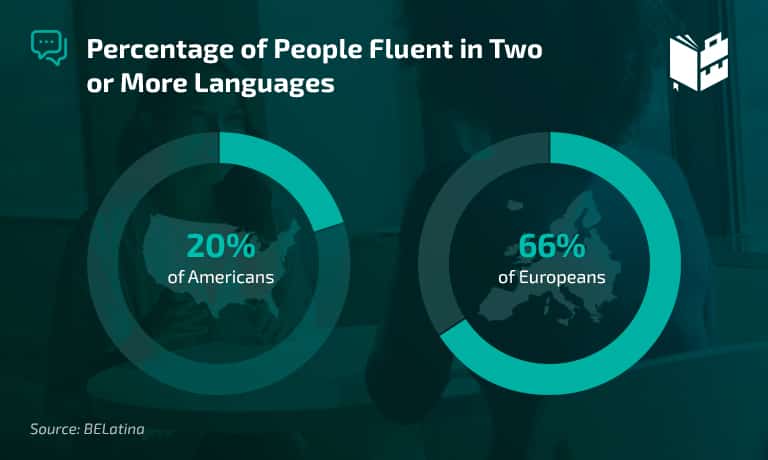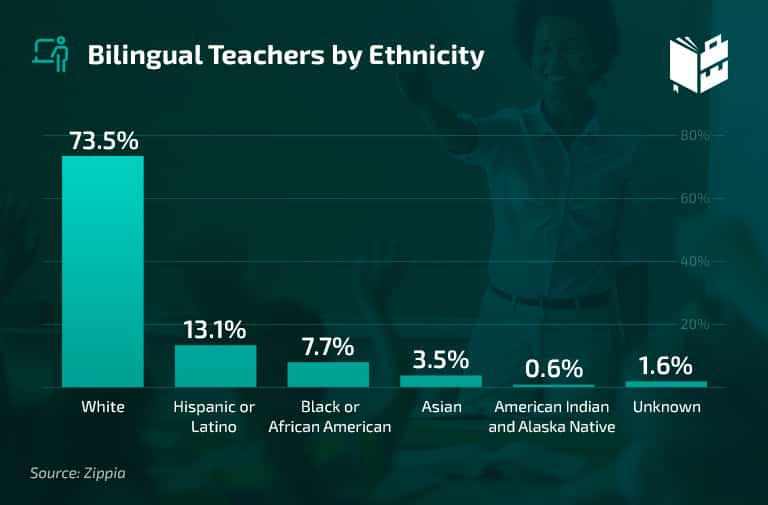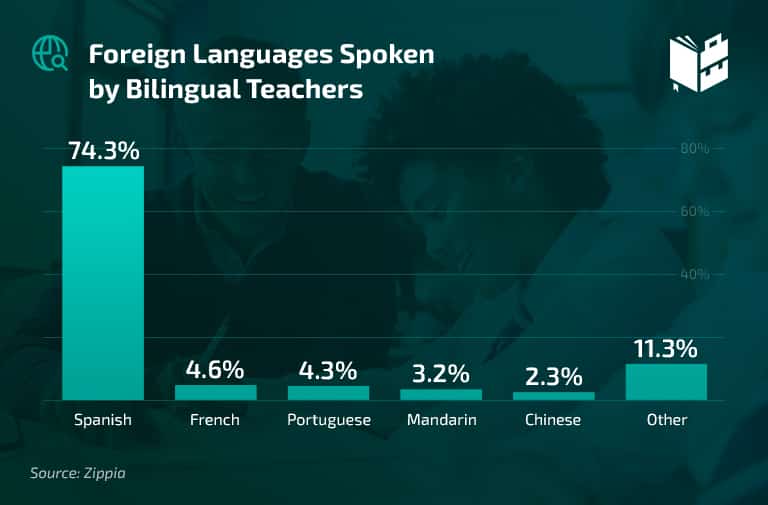Bilingual education, which implies that the same academic curriculum is taught in more than one language, has become extremely popular. According to bilingual education statistics, around half of the human race is bilingual to some extent. The need for teaching students in both their mother tongue and another foreign language is increasing day by day.
Nevertheless, the effectiveness of this type of education remains a subject of debate. Some consider it highly necessary, while others think that this education principle can be stressful for students.
Stand-Out Bilingual Education Stats (Editor’s Choice)
- Language experts claim that about one-half of people worldwide are bilingual.
- Around 20% of American residents speak two or more languages.
- Approximately 5 million students in the United States are English Language Learners.
- At 14.7%, the largest percentage of ELLs comes from urban areas.
- There are about 3,000 dual-language programs nationwide.
- Only 9% of teachers have a Hispanic origin.
- Over a decade, the number of EL students in Mississippi has grown by 235%.
- 3.8 million ELLs in America come from Spanish-speaking countries.
General Bilingual Statistics
1. Language experts claim that about one-half of people worldwide are bilingual.
(The Washington Post)
Although it is challenging to provide a 100% accurate number when it comes to bilingualism, most of the world’s experts have concluded that half of humankind is bilingual. Studying a second language has been associated with improved learning in other subjects, the development of empathy, and improved cognitive ability.
2. Only 20% of Americans can communicate in two or more languages.
(The Washington Post, BELatina)
The latest research regarding the percentage of bilingual speakers in the US shows that only 20% of Americans can properly use two or more languages fluently. Due to many bordering countries, around 66% of Europeans are bilingual and regularly converse in their native tongue and in English.
As the primary language for the North American continent is English, there has been little need for residents to learn to speak anything else.

3. The percentage of Americans who are bilingual has doubled from 1980 until 2018.
(Psychology Today)
The U.S. Census Bureau gathered data on bilingual residents every ten years from 1980 to 2000. Over 38 years, the number of bilingual people in the US has doubled, with experts estimating 23% of the country’s population. In 1980, just 10.68% of people in the US were bilingual, while the report for 2018 shows 20.55% or 63 million US citizens.
4. Approximately 5 million students in the United States are English Language Learners.
(School of Education)
When we talk about bilingual education studies in the US, we are not only considering students who require education in a language other than English. There are 5 million students in the US who are non-English speakers and belong to the category of English Language Learners. Additionally, data shows that these students are more likely to struggle academically. Just 67% of them will graduate from high school compared to 84% of all students.
5. Bilingual education costs between $200 and $700 more per student compared to alternative approaches.
(The Fiscal Times)
Various studies on the cost of bilingual education concluded that such an education model requires more funds than the traditional approach. In some states, the extra cost for bilingual education ranges between $200 and $700 per student. For example, schools in Texas with a bilingual program spend $402 more per pupil than schools that don’t provide bilingual education.
6. At 14.7%, the largest percentage of ELLs comes from urban areas.
(NCES)
Bilingual education in elementary school statistics show that ELL student enrollment accounts for 14.7% of city schools, 9.6% of schools located in suburban areas, 6.8% of town schools, and 4.1% of schools in rural areas. In addition, ELLs account for a higher percentage of students with low grades.
7. 3.8 million ELLs in America come from Spanish-speaking countries.
(VOA News, BELatina)
The majority of ELLs who take part in dual education come from a country in which Spanish is the national language. Recent numbers show that 3.8 million US students are native Spanish-speakers who aren’t English proficient. Other most spoken languages among ELLs based on the bilingual education demographics include Chinese, Arabic, Vietnamese, and Haitian Creole speakers. These students combined account for 92% of the total number of ELLs.
8. There are about 3,000 dual-language programs nationwide.
(USA Today)
The latest numbers reveal a massive increase in dual-language programs nationwide. In 2001, there were only 300, and the number has climbed to 3,000. The number of programs increased as a response to the high demand, and recent research revealed that 58% of school districts across the US have plans to expand bilingual programs.
9. In over a decade, the number of ELL students in Mississippi has grown by 235%.
(USA Today)
When analyzing bilingual statistics in America, states that did not traditionally have bilingual programs are now seeing a dramatic surge of ELL students. The latest data reveals that Mississippi saw a 235% increase, South Carolina 196%, and Kentucky 118%. On the other hand, Delaware and Iowa have experienced a moderate jump in ELL students, with 64% and 73% growth.
Dual Language Teachers and Bilingual Education Stats
10. Only 9% of teachers have a Hispanic origin.
(BELatina)
The largest minority demographics in the US schools are Latinx, and students of Hispanic origin account for 22% of the total number of students. There is an apparent shortage of teachers, however, as they account for just 9% of the teacher workforce in the country.
11. 73.5% of bilingual teachers are White.
(Zippia)
Bilingual jobs statistics reveal that the majority of bilingual teachers are White. Hispanic or Latinx teachers make up 13.1% of all bilingual teachers, whereas 7.7% are Black or African American. About 3.5% of bilingual teachers are Asian, and only 0.6% are American Indian or Alaska Native.

12. The average age of bilingual teachers is 40+.
(Zippia)
64% of bilingual teachers are women. Furthermore, bilingual education data shows that 58% of all bilingual teachers are over the age of 40. An additional 29% are aged 30-40 years, and 14% are between 20 and 30.
13. 74.3% of bilingual teachers speak Spanish.
(Zippia)
The most popular foreign language of bilingual teachers is Spanish. French is the second-most popular language at 4.6%, followed by Portuguese at 4.3%. Furthermore, about 3.2% of bilingual teachers speak Mandarin, 2.3% speak Chinese, and 11.3% speak another language.

14. More than 30 US states stated that there is a critical shortage of ESL teachers.
(USA Today)
The latest statistics on teachers in bilingual education show a shortage of teachers who work in dual-language immersion, bilingual, and other transitional language programs. The lack of teachers becomes more evident as the number of students who need bilingual education grows.
15. 86% of school districts stopped the plans for expansion of bilingual programs due to teacher shortages.
(VOA News)
A public opinion study from 2017 discovered that 58% of school districts wanted to expand bilingual programs and even add some new ones to their education system. Statistics on bilingual education state, however, that 86% of the districts had to put their plans to a halt due to the lack of competent bilingual teachers.
16. Male bilingual teachers make $54,224 compared to female teachers who make $52,890.
(Zippia)
Recent data shows a gender disparity when it comes to bilingual teacher salaries. Male teachers make on average $54,224, whereas the average salary for female teachers is $52,890. Additionally, the salaries vary by gender and ethnicity, with Asian and Hispanic men making more compared to others.
Benefits of Bilingual Education
17. Bilingual education helps students adapt more quickly and learn new things with less effort.
(The Parents Zone)
Studies show that students who are bilingual are more adaptable to learning new things. As learning a new language exposes children to new cultures, sounds, and even ways of understanding, they become more well-rounded and open to multiple perspectives.
18. Bilingual education reduces discrimination and teaches integration and diversity.
(NPR)
One of the greatest benefits of dual-language programs is that it teaches students to avoid drawing lines between different cultures and accept diversity as an integral component of life. Through exposure, learning a new language shows the perspective of the culture surrounding it and sensitizes students to the concept of difference.
19. Students who become proficient in two languages have better chances to build a successful career.
(The Parents Zone)
Bilingual education statistics show the more languages you speak, the more job opportunities are available. Not only does being bilingual create more available positions, but it also provides candidates with a competitive edge, regardless of the language requirements for the position.
20. Bilingual people develop better social skills.
(New York Times)
A study done on bilingual people demonstrated that this skill is a good base for a better understanding of other human beings, their intentions, and actions. Learning a new language requires understanding that not all people see the world the same, and bilingual education research shows this aids in the development of empathy.
21. Bilingual people are less likely to get diagnosed with Alzheimer’s disease.
(BBC)
Being bilingual can prevent the development of Alzheimer’s disease and slow down the process of dementia. According to research done by psycholinguist Ellen Bialystok, bilingual people usually show the first symptoms of Alzheimer’s approximately five years later than monolingual people.
22. Bilingual education is often most effective when children are beginning preschool or elementary school.
(School of Education)
During childhood, humans can acquire language effortlessly without spending hours studying it. Many experts claim that the effectiveness of bilingual education is most apparent in kindergarten or the first few years of elementary school. After stepping into adulthood, language acquisition becomes a more demanding process.
23. Bilingual education helps students improve focus and attention span.
(NPR)
Bilingualism requires the ability to properly recognize patterns of language and switch between codes in order to respond appropriately. This process has been shown to improve focus and help students increase their attention span.
24. Some teachers believe that bilingual students face more difficulties learning to read than students who only speak one language.
(Waterford)
Bilingual education facts show that bilingual children develop pre-reading skills earlier than their unilingual peers, such as learning new sounds, retaining new words, and knowing what books are and how to use them.
Some early reports on the outcomes of bilingual education indicated that it might cause difficulties with learning to read. This myth continues to prevail, but recent studies indicate the opposite. New research on bilingual education shows positive outcomes such as sociability, increased focus and attention span, and high adaptability as outcomes.
25. Bilingual education statistics show that bilingual students often outperform their monolingual peers in tasks where executive control is needed.
(Waterford)
Bilingual students develop more remarkable perseverance, self-discipline, and other goal-achieving skills. In addition to higher abstract thinking capabilities, this helps students develop the intellect and the motivation needed to perform tasks and assignments where executive control is required.
FAQ
How does bilingual education affect students?
Multiple studies have been done on the effects of bilingual education on students of different ages. On one side, it’s found that being able to communicate in more than one language is a useful skill that can be highly beneficial throughout life. Some students might get overwhelmed by the need to study two languages at once, however, and lose interest in education entirely.
Is bilingual education effective?
Many experts agree that bilingual education has positive effects on the brain and enhances the learning process. That being said, the effectiveness of bilingual programs varies from state to state, and school to school. Teacher shortages, pedagogical approach, and funding are just a few issues that impact the effectiveness of these programs, with many wondering if it’s worth the cost at all.
Why is bilingual education controversial?
Bilingual education has been an open topic for years in the US, and many education experts together with politicians consider it controversial. One of the reasons for such an approach toward bilingual education is its close relation to immigration issues.
Secondly, the research on the effectiveness of bilingual education is mixed, with many still believing that it causes reduced learning outcomes for children in both languages. In response to this, the English First movement in the US combats the funding of bilingual education in state schools.
What is the main purpose of bilingual education?
There are several reasons behind bilingual education. ESL programs, for example, aid students who speak a native language other than English to acquire fluency, attend school, and function in US society.
Bilingual programs, on the other hand, teach native English speakers to speak a second language, in most cases, Spanish. While not the official second language of the United States, Spanish is spoken by 41 million people across the country and is the most commonly spoken language other than English.
What are the benefits of bilingual education?
Bilingual education has many benefits for students both in and out of the classroom. Firstly, bilingual students have been shown to develop pre-reading skills much faster than monolingual students and are more adept at learning new things and expressing empathy. Bilingualism is also connected to many additional cognitive benefits, such as better memory, creativity, multitasking skills, social skills, and more.
Is bilingual education good or bad?
Bilingual education is neither good nor bad. While many question the effectiveness of programs and the impact on student learning, many new studies claim that it provides great benefits to students and society as a whole.
There are many reasons why a particular program might be bad due to poor teaching or funding, and undoubtedly much good comes from learning a second language. Still, bilingual education statistics show, it’s immigration that will predict the future of bilingual education in the United States.
Sources:
BBC, BELatina, NPR, NCES, Psychology Today, School of Education, The Fiscal Times, The Parents Zone, The New York Times, The Washington Post, VOA, Waterford, Zippia